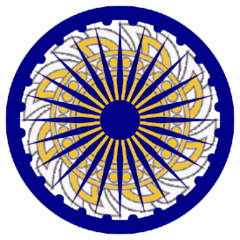Charsidhanism: Difference between revisions
(Created page with "{{WIP}} {{Region icon Kylaris}} Category:Rajyaghar Category:Politics of Rajyaghar{{Infobox political party | name = Charsidhanism | native_name = चरसिडान...") |
|||
| Line 32: | Line 32: | ||
==Symbolism== | ==Symbolism== | ||
[[File: Charsidhan.png|100px|right|thumb|Symbol of Charsidhan]] | [[File: Charsidhan.png|100px|right|thumb|Symbol of Charsidhan]] | ||
The ''Charsidhan Chakra'', the symbol of charsidhanism, | The ''Charsidhan Chakra'', the symbol of charsidhanism, is a combination of two chakras, the {{wp|Ashoka Chakra|Jhanda Chakra}} and the {{wp|Sudarshana Chakra|Yoddha Chakra}}. The Jhanda Chakra's inclusion is a reflection on the dominance of the Jhanda Empire and its lasting influence in the Naratha River Basin and the subsequent middle kingdoms that succeeded it. During the reign of the Jhanda Empire, the chakra was used as a symbol of unity, uniting the city-states that fell under its control. In modern-times, the Jhanda Chakra represents the unity of the nation. The Yoddha Chakra was incorprated as a reflection of the nation's military history as well as the principle of militarism, a key principle of Charsidhanism. | ||
When independence was first announced to be achieved upon the conclusion of the [[Solarian War]], the nation's forefathers began to develop the symbols, flags and seals for the soon-to-be independent Rajyaghar. To promote charsidhan, it's symbol would be | When independence was first announced to be achieved upon the conclusion of the [[Solarian War]], the nation's forefathers began to develop the symbols, flags and seals for the soon-to-be independent Rajyaghar. To promote charsidhan and enshrine it as the national ideology, it's symbol would be adopted as the [[Symbols of Rajyaghar|State Seal]], be incorporated into the [[Symbols of Rajyaghar|Royal Seal]] and feature prominently on various national and union state symbols. | ||
===Use of the Charsidhan Chakra=== | ===Use of the Charsidhan Chakra=== | ||
<gallery> | <gallery> | ||
Charsidhan.png|State Seal of Rajyaghar | |||
RajyagharSeal.png|Royal Seal | RajyagharSeal.png|Royal Seal | ||
</gallery> | </gallery> | ||
{{Rajyaghar}} | {{Rajyaghar}} | ||
Revision as of 12:37, 28 March 2021
This article is incomplete because it is pending further input from participants, or it is a work-in-progress by one author. Please comment on this article's talk page to share your input, comments and questions. Note: To contribute to this article, you may need to seek help from the author(s) of this page. |
Charsidhanism चरसिडानिज्म | |
|---|---|
 | |
| Adopted | October 17, 1946 |
| Ideology | Territorial Nationalism Rajyani Nationalism Monarchism Militarism |
| Country | |
Charsidhanism (Matrabashi: चरसिडानिज्म), sometimes referred to as "the four principles", is a rajyani ideology that, since independence in October 1946, has been the national ideology of the Kingdom of Rajyaghar. Charsidhanism, the implementation of the charsidhan philosophy, was developed during the Solarian War in a bid to ensure national unity following independence, to act against growing pan-satrian from neighbouring Ajahadya, and to provide military strength to protect against invasion. Specifically, charsidhanism was developed to encompass the four principles of territorial nationalism, rajyani nationalism, monarchism and militarism.
The absence of ethnic nationalism and religious nationalism from the ideology gained it support from the ethnnic minority groups in the south and east of Rajyaghar, particularly in Pinjar and Zulmat as well as support from the irfanic and badi groups across the country. The inclusion of monarchism was a compromise to the tulyatan majority who feared a minority head of state.
Origins
Four Principles
Territorial Nationalism
Rajyani Nationalism
Monarchism
Militarism
Usage in Rajyaghar
Criticism
Symbolism
The Charsidhan Chakra, the symbol of charsidhanism, is a combination of two chakras, the Jhanda Chakra and the Yoddha Chakra. The Jhanda Chakra's inclusion is a reflection on the dominance of the Jhanda Empire and its lasting influence in the Naratha River Basin and the subsequent middle kingdoms that succeeded it. During the reign of the Jhanda Empire, the chakra was used as a symbol of unity, uniting the city-states that fell under its control. In modern-times, the Jhanda Chakra represents the unity of the nation. The Yoddha Chakra was incorprated as a reflection of the nation's military history as well as the principle of militarism, a key principle of Charsidhanism.
When independence was first announced to be achieved upon the conclusion of the Solarian War, the nation's forefathers began to develop the symbols, flags and seals for the soon-to-be independent Rajyaghar. To promote charsidhan and enshrine it as the national ideology, it's symbol would be adopted as the State Seal, be incorporated into the Royal Seal and feature prominently on various national and union state symbols.


